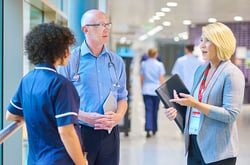I recently visited a client to attend the kickoff of a project to reconceive and update the patient experience from the ambulatory perspective. Let me pause for a bit and reiterate what I just wrote: I visited a client – in person, at their hospital. In the Before Times, that statement wouldn’t draw any attention. In the past, I regularly met with clients by traveling to them.
While we’ve had telephone and video-call capabilities forever (or maybe it just seems so), airlines and hotels have always embraced the business traveler because they were a constant source of income. Travel hasn’t been easy, cheap, or stress-free for decades, but businesspeople continue to go on trips because that’s the most effective way to learn about a client, their struggles, and their potential opportunities. Sure, video calls are now omnipresent, but you can only gather certain information from such a communication medium. If it’s pure data that you’re after, calls will fit the bill. How many physicians work at a certain clinic? How do billers interact with the various work queues? What is the governance structure for information technology (IT) decisions in the health system? That sort of data can be collected from a call.
 While data can be elicited from afar, real knowledge often comes uniquely from onsite interactions. I recently read that most of the important things folks discover about clients come just before and after the “official” meetings. I couldn’t agree more! It’s the pre-meeting, post-meeting, and meal sharing where the real learnings occur, and that’s what has been missing from our pandemic business way of life.
While data can be elicited from afar, real knowledge often comes uniquely from onsite interactions. I recently read that most of the important things folks discover about clients come just before and after the “official” meetings. I couldn’t agree more! It’s the pre-meeting, post-meeting, and meal sharing where the real learnings occur, and that’s what has been missing from our pandemic business way of life.
Consider the examples of data collection I just mentioned. On a Zoom or Teams call, if one asks about IT governance structures, charts and process diagrams will likely be shared. We’ll learn how to submit a project, what forms must be filled out, how requests are evaluated and prioritized, and who makes decisions. Heck, that is exactly what will likely happen in a face-to-face meeting as well. However, let’s consider the walk to the stairs afterwards. That’s when someone will whisper, “Sure, that’s how the governance process works on paper, but in real life, it’s a bit different. We all know that if you stake out the elevators near the C-suite and corner the COO to lobby for a project, it’s much more likely to get prioritized higher.” That is essential information that helps a consultant understand what’s really happening at a client site, and this type of information almost exclusively comes from being onsite and in the real world.
I’m not implying that teleconferences and video calls are useless; far from it. The pandemic has shown us that many of our assumptions about how business must be conducted were wrong. Online collaboration tools have enabled teams to meet virtually and get real, honest-to-goodness work done. Work from home (WFH) that was either frowned upon or completely disallowed is now commonplace, and not just in industries like technology or finance. The ability to get at least some work done from wherever one is located is a boon for employer and employee alike. Yet some things need to be done – and learned – in person.
How does one decide when traveling onsite is worthwhile? I think timing is everything. At the beginning of a project, it’s essential to be with a client so that you can learn their culture, the way they talk, and what they talk about. Who are the “players”? Where are decisions really made? All these questions set the stage for the rest of the work you’ll be doing. Of course, some meetings are more important than others. It’s important to be present for key decision-making meetings so you can “read the room,” pick up on non-verbal cues, and most fundamentally, be out in the hallway during breaks when the most important information is there for the gleaning. Finally, as the project is wrapping up, I like to be onsite to ensure that leadership truly understands our recommendations and is properly set up for long-term success after the team leaves.
Are you wondering what happened at the client meeting I wrote about at the beginning of this blog post? It was great! I learned that the CEO is highly engaged in the project, that the physicians are excited about the changes that will be coming but are concerned about communication, and that the project team has the right tools and mindset to pull it all off. Not shockingly, much of this knowledge came from outside of regularly scheduled meetings. And that’s just the way it should be!